
Stewed Carp with Starch Noodles: A Nutritious and Unique Traditional Dish. This dish has its roots in the rural areas of Northeast China and was invented by farmers during winter to save ingredients. It cleverly combines carp and starch noodles, presenting a diverse range of textures and nutritional value. The starch noodles in this dish absorb the essence of the fish broth, resulting in a smooth and tender texture. The carp meat is delicious and packed with nutrients. Not only does this dish have a rich flavor, but it also provides warmth and comfort, making it perfect for consumption during the cold winter season. Whether it’s a family dinner or a gathering with friends, this dish is definitely one not to be missed.
Ingredients for Stewed Carp with Starch Noodles:
| Carp | 500g |
| Chinese cabbage | 200g |
| Starch noodles | 100g |
| Salt | 6g |
| Garlic | 5g |
| Green onion | 5g |
| Ginger | 5g |
| Star anise | 3g |
| Fragrant leaves | 3g |
| Light soy sauce | 5g |
| Dark soy sauce | 3g |
| Oyster sauce | 3g |
| Cooking wine | 5g |
| Sugar | 3g |
| Bean paste | 5g |
| Dried chilli | 5g |
Step:
1.Place the cleaned fish on a cutting board, preparing for the next step of processing. Use a technique called “changing the knife” to make evenly spaced cuts approximately one finger-width apart. This method ensures that the fish’s cuts are uniform and visually appealing. Before starting to cut, carefully observe the shape and texture of the fish. Choose an appropriate angle to maintain stability and control the cutting force. Then, rhythmically and gently make the cuts along the fish’s body, allowing each cut to go through the skin and flesh without piercing the internal organs. By maintaining a finger-width gap between each cut, the resulting fish slices or chunks will be neater and retain the integrity of the fish. This processing method also promotes even heating during cooking, preserving the tenderness and texture of the fish. Therefore, when handling fish, it is important to pay attention to proper knife techniques and spacing between cuts.
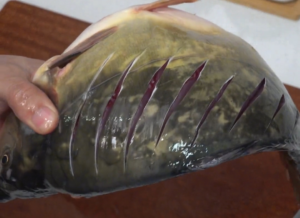
2.Prepare fresh Chinese cabbage and tear it into strips. This method helps maintain the original texture and mouthfeel of the cabbage and allows it to blend well with the dish. First, separate the leaves of the Chinese cabbage by hand, ensuring that each leaf is intact and clean. Then, place a cabbage leaf on a flat surface and gently tear it apart using both hands. By pulling outward, we can tear the cabbage leaf into longer and moderately wide strips. Repeat this process, tearing all the cabbage leaves into even strips.
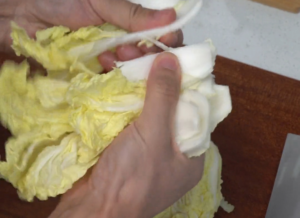
3.Before preparing the starch noodles, they need to be soaked until soft. First, place the starch noodles in a container and pour in enough water to completely submerge them. Allow the starch noodles to soak in the water for a period of time, which will vary depending on the type and thickness of the noodles. Observe the level of softening of the noodles—when you gently pinch the noodles, they should break instantly, indicating that they are properly soaked. It is important not to over-soak the noodles as they may become too soft and mushy, affecting the texture. Therefore, monitor the soaking time to ensure that the starch noodles maintain a certain level of resilience and elasticity.

4.Heat the oil in a wok or frying pan. Pour an appropriate amount of cooking oil into the wok, spreading it evenly on the bottom. Then, gently tilt and swirl the wok to ensure the oil covers the entire surface. Next, pour out the excess oil, leaving only a small amount in the wok. This helps remove excess grease, reduce oil usage, and maintain the texture and healthiness of the dish. Sprinkle a pinch of salt evenly into the oil. Salt not only enhances the flavor but also increases the temperature of the wok, making it easier to sear the fish. Continue heating the oil until a faint wisp of smoke appears. This indicates that the oil has reached the ideal temperature for frying the fish. Carefully place the prepared fish into the wok, ensuring it stays stable and not moving hastily. Allow the fish to fry undisturbed for 20 seconds, which helps the fish hold its shape and prevents sticking to the wok. After the initial searing, gently slide a spatula under the fish to separate it from the bottom of the wok, preventing it from sticking. Continue frying the fish until both sides are golden brown, flipping it once to ensure even heating. Finally, pour out any excess oil, ensuring that the fish is not overly greasy and that the frying is uniform. Following this process will result in a crispy exterior and tender interior. Pay attention to the timing and heat to ensure thorough frying while maintaining the delicate texture of the fish.
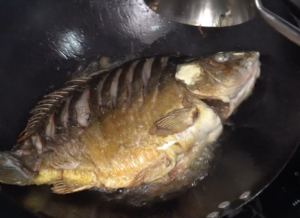
5.Add a little bit of cooking oil back into the pot, and heat it up. Then pour in an appropriate amount of bean paste. Stir-fry the bean paste until the oil separates and a rich aroma is released. Next, add minced garlic, chopped green onions, ginger, star anise, fragrant leaves, and dried chili to the pot. Quickly mix them together using a spatula or spoon, ensuring that the seasonings are well blended and releasing their flavors. Then, pour in a moderate amount of light soy sauce, oyster sauce, and cooking wine along the edges of the pot. Sprinkle some salt and sugar evenly while stirring again, making sure the seasonings coat the ingredients uniformly. Afterwards, add enough warm water to submerge all the ingredients completely. If the color seems too light, you can add a small amount of dark soy sauce to enhance the color. Finally, cover the pot with a lid, adjust the heat to medium-low, and simmer for about 10 minutes. This simmering process allows the ingredients to fully absorb the flavor of the seasonings, resulting in a tender and delicious taste. Through simmering, the fragrance and flavor of the seasonings will penetrate into the ingredients, creating a rich broth. In the end, we can enjoy a visually appealing and flavorful dish.
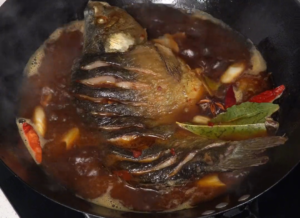
6.After simmering for about 10 minutes, open the lid of the pot. Carefully add torn Chinese cabbage leaves along the edge of the pot. Use a spatula or spoon to stir-fry the cabbage leaves with the cooked fish and seasonings, ensuring that each leaf is coated with the seasonings. Then, cover the pot again and continue to simmer for another 5 minutes. This allows the Chinese cabbage leaves to absorb the flavors of the fish broth and seasonings, softening them and adding texture. After simmering, you’ll see that the Chinese cabbage leaves have become tender and infused with the aroma of the fish broth and seasonings. At this point, the dish combines the deliciousness of the fish with the freshness of the Chinese cabbage, providing a flavorful culinary experience.
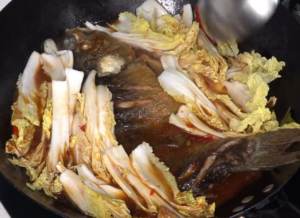
7.In the last 5 minutes of simmering, carefully add pre-soaked starch noodles into the pot. Spread the noodles evenly over the fish, ensuring they come into contact with the fish broth and seasonings. Then, cover the pot again and continue to simmer for 5 minutes. This allows the starch noodles to absorb the flavors of the fish broth and seasonings while becoming soft and flavorful. After simmering, you’ll find that the noodles have become plump and elastic, perfectly blending with the texture of the fish and Chinese cabbage. This enhances the layers of the dish and makes it even more mouth-watering.
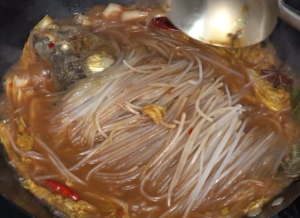
8.Once the starch noodles have absorbed the flavors, carefully remove the entire dish from the pot and transfer it onto a plate. Try to maintain the integrity of the fish, Chinese cabbage, and starch noodles to make it visually appealing. When plating, place the braised fish in the center of the plate and neatly arrange the starch noodles and Chinese cabbage around it. This not only highlights the importance of the main ingredients but also adds layers and visual appeal to the dish. You can also sprinkle some chopped green onions, cilantro, or chili threads on top as garnish to add color and texture. These decorations not only enhance the aesthetics of the dish but also stimulate the appetite of the diners.
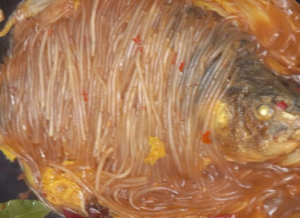
Tips:
1.Use fresh carp and high-quality starch noodles to ensure the quality and texture of the ingredients.
2.During the simmering process, pay attention to the doneness of the ingredients to avoid overcooking or undercooking, which can affect the texture.
Stewed Carp with Starch Noodles is an authentic delicacy that combines the unique flavors of Northeast China with abundant nutritional value. The star ingredients of this dish are fresh carp and high-quality starch noodles, which intertwine and create a distinctive texture during slow simmering. The starch noodles absorb the deliciousness of the fish meat and the richness of the broth, becoming silky, tender, and plump. The carp meat, on the other hand, becomes tender, succulent, and juicy after prolonged simmering. This dish is fragrant and highly appetizing. Moreover, it is rich in protein, vitamins, minerals, and other essential nutrients, providing ample energy and nutrition for the body. Stewed Carp with Starch Noodles is not only a culinary delight but also a nutritious delicacy.

